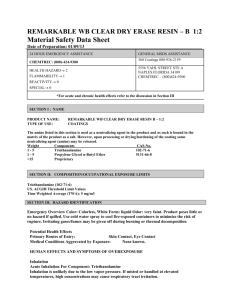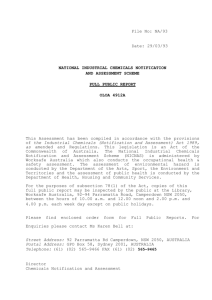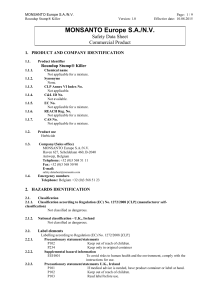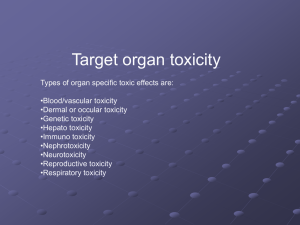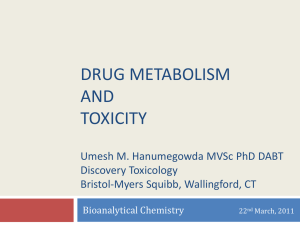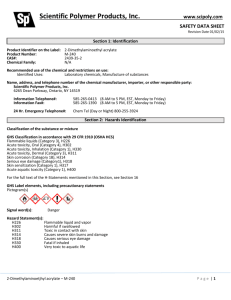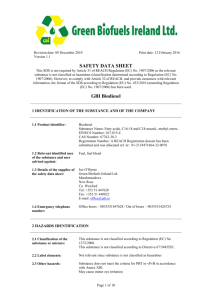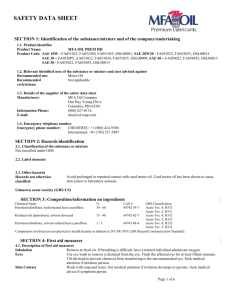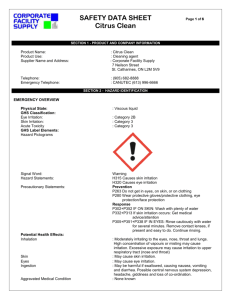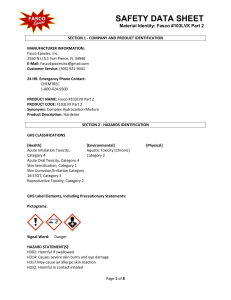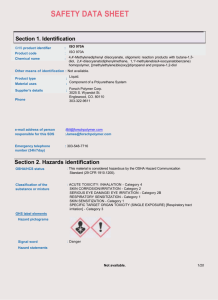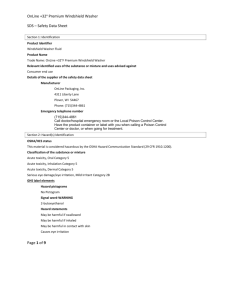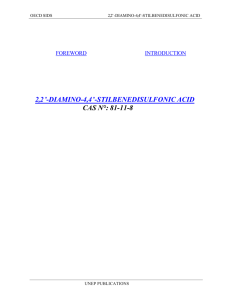TOXICOLOGY STUDIES IN LABORATORY ANIMALS
advertisement
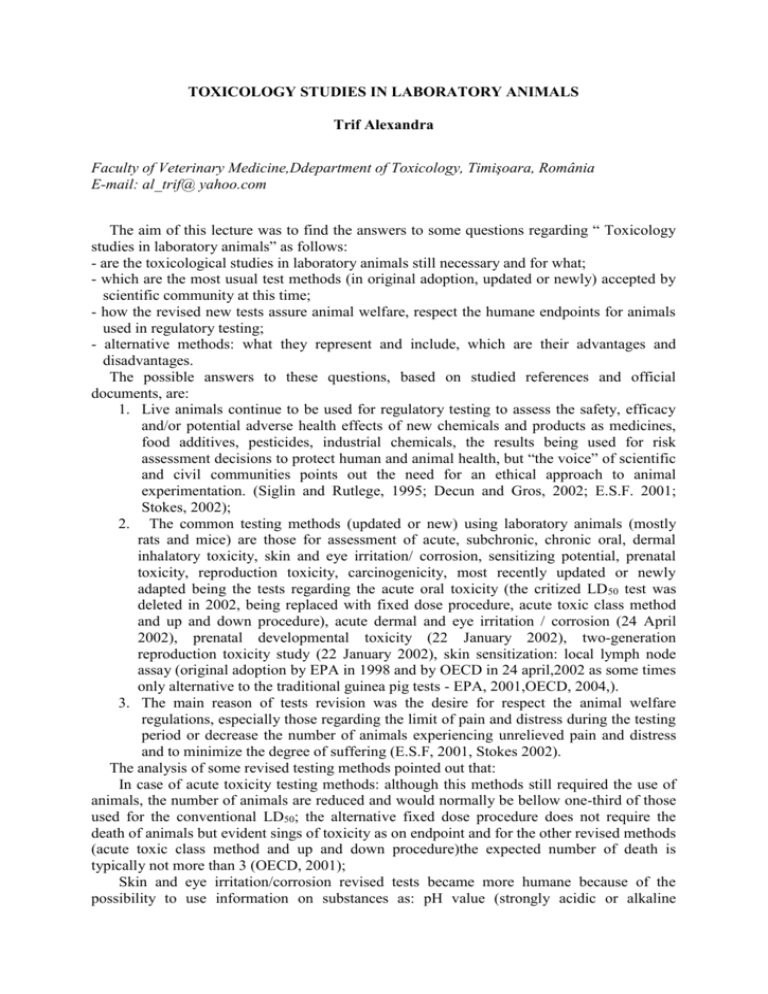
TOXICOLOGY STUDIES IN LABORATORY ANIMALS Trif Alexandra Faculty of Veterinary Medicine,Ddepartment of Toxicology, Timişoara, România E-mail: al_trif@ yahoo.com The aim of this lecture was to find the answers to some questions regarding “ Toxicology studies in laboratory animals” as follows: - are the toxicological studies in laboratory animals still necessary and for what; - which are the most usual test methods (in original adoption, updated or newly) accepted by scientific community at this time; - how the revised new tests assure animal welfare, respect the humane endpoints for animals used in regulatory testing; - alternative methods: what they represent and include, which are their advantages and disadvantages. The possible answers to these questions, based on studied references and official documents, are: 1. Live animals continue to be used for regulatory testing to assess the safety, efficacy and/or potential adverse health effects of new chemicals and products as medicines, food additives, pesticides, industrial chemicals, the results being used for risk assessment decisions to protect human and animal health, but “the voice” of scientific and civil communities points out the need for an ethical approach to animal experimentation. (Siglin and Rutlege, 1995; Decun and Gros, 2002; E.S.F. 2001; Stokes, 2002); 2. The common testing methods (updated or new) using laboratory animals (mostly rats and mice) are those for assessment of acute, subchronic, chronic oral, dermal inhalatory toxicity, skin and eye irritation/ corrosion, sensitizing potential, prenatal toxicity, reproduction toxicity, carcinogenicity, most recently updated or newly adapted being the tests regarding the acute oral toxicity (the critized LD50 test was deleted in 2002, being replaced with fixed dose procedure, acute toxic class method and up and down procedure), acute dermal and eye irritation / corrosion (24 April 2002), prenatal developmental toxicity (22 January 2002), two-generation reproduction toxicity study (22 January 2002), skin sensitization: local lymph node assay (original adoption by EPA in 1998 and by OECD in 24 april,2002 as some times only alternative to the traditional guinea pig tests - EPA, 2001,OECD, 2004,). 3. The main reason of tests revision was the desire for respect the animal welfare regulations, especially those regarding the limit of pain and distress during the testing period or decrease the number of animals experiencing unrelieved pain and distress and to minimize the degree of suffering (E.S.F, 2001, Stokes 2002). The analysis of some revised testing methods pointed out that: In case of acute toxicity testing methods: although this methods still required the use of animals, the number of animals are reduced and would normally be bellow one-third of those used for the conventional LD50; the alternative fixed dose procedure does not require the death of animals but evident sings of toxicity as on endpoint and for the other revised methods (acute toxic class method and up and down procedure)the expected number of death is typically not more than 3 (OECD, 2001); Skin and eye irritation/corrosion revised tests became more humane because of the possibility to use information on substances as: pH value (strongly acidic or alkaline substances may not require testing), results from acute toxicity studies (if dose level of 2000mg/kg b.w. is used for an acute dermal toxicity test and no skin irritation is observed, further testing may be unnecessary) and the results of a well validated in vitro test for skin irritation / corrosion testing (if severe effects evidence are available, a complete test may not be required) and a known severe dermal irritation and corrosive effect for ocular irritation studies (the classification might be made without further testing) (Stokes, 2002). All the above mentioned methods state the humanely killing of the moribund or suffering severe pain and distress animals. In chronic rodent toxicity and carcinogenicity studies some clinical sings that may indicate severe conditions that may progress to pain and clinical chemistry may be helpful in identifying of impending death, can serve as earlier humane endpoints allowing for animals to be humanely killed (Stokes, 2002). In last period alternative methods has been developing; this “alternatives” include the so named “three Rs”: reduction (lowering the number of animals in experiments to the minimum that allowed to obtain meaningful results), refinement (development of new procedures less severe and less inhumane, so that the degree of suffering is minimized), replacement (replace methods which use conscious live vertebrates by non – sentient material, by non –animal alternatives (Dolan, 1999; E.S.F, 2001; Osterberg, 2001). The revised methods partially assure “reduction” and “refinement”. Some of used / potential alternatives are: “ in vitro studies” (i.e. assays using liver tissue or cell for toxicity screens); transgenic alternatives to standard rodent bioassay in carcinogenetic studies, noninvasive imagining techniques (measure of metabolism, molecular functions, organ and tissue damage using biomarkers) (Osterberg, 2001). References Decun M., Gros V., 2002. Ethical aspects regarding animal experimentation. Lucr. st. med. Vet. Timisoara 35: 639-649. Dolan K., 1999. Ethics, animals and science. Oxford, Londra, Paris Blackwell Science. European Science Foundation (ESF), 2001. Use of animals in research. E.S.F. Policy Briefings, second edition, pp 1-6. Environmental Protection Agency, 2001. Local lymph node assay. Federal Register 66, pp 6801-6806. OECD, 1999a. Series on testing and assessment no. 13 Detailed Review document on classification systems for sensitizing substances in OECD member countries ENV/JM/MONO 3: 10-23. O.E.C.D, 1999b. Series in testing and assessment no. 14 OECD Detailed Review Document on classification System for Eye Irritation / Corrosion in OECD Member Countries. ENV/JM/MONO:11-38. OECD, 2001. Guidance document on acute oral toxicity testing. OECD Series on testing and assement no. 24. ENV / JM/ MONO. 4: 8-24. OECD 2004. Chemicals- Sections 4- Health effects (pink pages). Osterberg R.E., 2001. ICH Approaches to reducing animal use – abstract for Proc. of the workshop: TestSmart- Pharmaceuticals Efficient and Humane Approach to Predictors of Potential Toxic Effects of Drugs, 7-9 May Baltimore, Maryland, USA, http://caat.jhsph.edu/programs/workshops/ testsmart/pharm/osterberg.htm. Siglin J.C., Rutlege G.M., 1995. Laboratory animal management. In: Derelanko J., M., Hollinger M.A., (ed). CRC Handbook of Toxicology, CRC Press. Jnc., pp 1-50. Stokes W.S., 2002. Humane endpoints for laboratory animal used in regulatory testings. ILAR J., 43, Supplement, 1-12.


